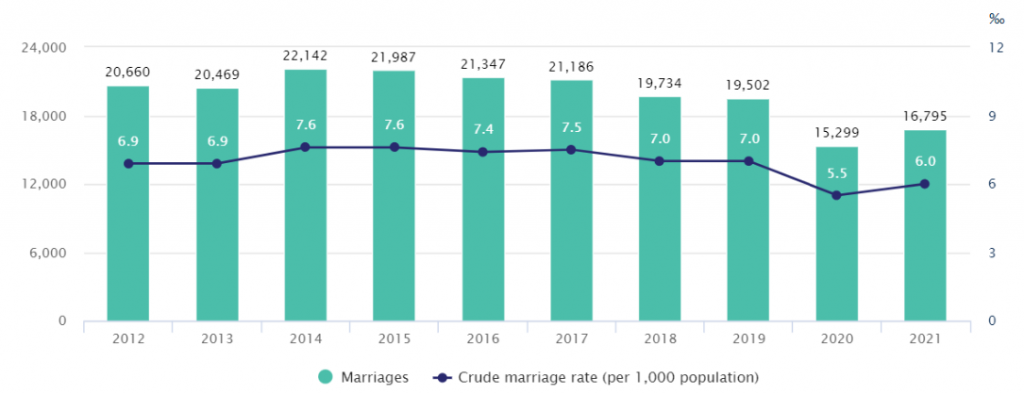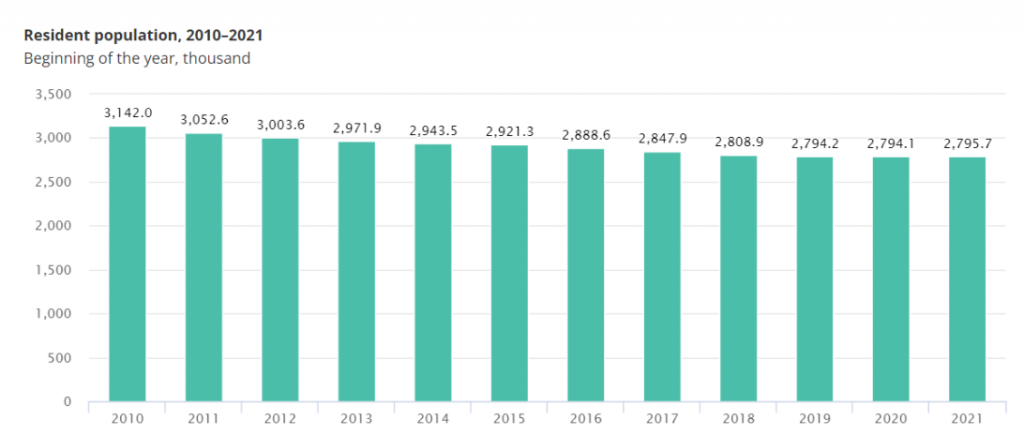Weekly Briefing, Vol. 57. No. 3 (LT) December 2022
Trends of Lithuanian population changes
Summary
After many years of decline, in 2021 Lithuania’s population grew for the first time during the last three decades, and this year this growth has noticeably accelerated. Population started growing because the positive net immigration to Lithuania has finally exceeded the negative natural change of the Lithuania’s population. The main reasons for the increasing net immigration figures is that of increasing Lithuania’s attractiveness in terms of economic development and political stability, the latter reason being especially important for Ukrainian and Belarusian nationals fleeing their countries. As far as the negative natural change of population is concerned, the negative trend remains strong, the number of births in Lithuania is not nearly enough to replace the number of deaths. However, it is possible that a stable number of marriages with reduced divorce rates may contribute to stabilizing the number of births in the near future.
Introduction
One of the greatest long-term problems in Lithuania is a decrease in population. If the population decrease does not stop, it will have a profound negative impact on long term expansion of Lithuania’s economy, culture, even national identity and national security. After many years of decline of Lithuania’s population, the year 2021 was a turnaround year, and for the first time Lithuania’s population stopped decreasing. Preliminary data shows that the year 2022 will bring even more good news for Lithuania’s population. This briefing will overview statistics and data that can explain the causes of these population changes. In particular, data of migration, births and deaths, marriages and divorces, and causes of population change will be covered.
Migration
For many years Lithuania has suffered from a so-called “brain drain”, a phenomena when highly trained and qualified people emigrate from the country. Since 2004, the year when Lithuania became a member of European Union and Schengen Area and when working in other countries became especially easy, the human capital flight from the country has intensified and reached a peak in 2010, when Lithuania lost about 80,000 residents due to net emigration.
However, as the standard of living and career opportunities have consistently improved in Lithuania, the numbers of emigrants have started gradually decreasing and immigration has been on the rise (see Graph 1). In 2018 there was a breaking point when the number of immigrants has exceeded that of emigrants. Graph 1 also shows that increasing immigration and decreasing emigration flows are the new trends that may last for a longer period of time rather than just a one-off occurrence.
Although the data for the year 2022 is not yet available, it is already known that it will be a record-breaking year in terms immigration as large numbers of Ukrainians and Belarusians have been arriving to Lithuania after the full-scale war broke out in Ukraine. Most of them have successfully applied for and been granted the permits of stay in the country, and hence are now included in the official statistics of Lithuanian residents.
Graph 1 – Annual figures of emigrants (light blue columns) and immigrants (dark blue columns) [1]

Roughly 50 per cent of immigrants are Lithuanian nationals returning to live and work in Lithuania after spending a period of time living and working abroad.[2] The net immigration to Lithuania of Lithuanian nationals has also turned positive in 2020 (see Graph 2), but this trend may have been amplified by the COVID pandemics in 2020 when many Lithuanians returned to their families in anticipation of COVID lockdowns. Whether this positive trend is sustainable and continues in the coming years remains to be seen. Nevertheless, it is a very positive trend, telling a lot about the perceived attractiveness of living in Lithuania relative to that of living in foreign countries.
Graph 2 – Numbers of immigrants (increasing line) and emigrants (decreasing line) of Lithuanian nationals [3]

Births and deaths
For many years there has been a negative natural population change in Lithuania when the number of deaths exceed the number of births. This trend has exacerbated over the last two years, affected by uncertainties during COVID pandemics (see Graph 3).
Graph 3 – Number of births [4]

It looks like the year 2022 will be the worst year in terms of births in Lithuania during the last couple of decades. Preliminary data shows that during eleven months of this year 19,865 births were recorded,[5] which means that there will be less than 22,000 births during the whole year of 2022.
On the other hand, the number of deaths has sharply increased during the last two years (see Graph 4). What is more, comparing Graph 3 and Graph 4, it is obvious that the number of deaths each year exceeds the number of births by a big margin, and therefore Lithuania has a constantly negative natural change of population.
Graph 4 – Number of deaths [6]

Lithuanian government has been offering monthly payouts to families having children, as well as one of the most flexible maternity/paternity leave in the EU, as well as other economic incentives. However, it seems these incentives are not enough to have a more significant positive impact on the number of children Lithuanians decide to have. Furthermore, decisions to have children are usually postponed in times of high economic, social or geopolitical insecurity. The phenomenon of drop in births has been observed throughout Europe, and also in Lithuania, during 2020-2021 COVID pandemic and related lockdowns. It may be that the war in Ukraine and related economic uncertainty has contributed to the postponement of having children for many couples.
Marriages and divorces
The annual number of marriages, after falling since 2014 and reaching a lowest point in 2020, when COVID lockdowns were in place, increased in 2021 (see Graph 5). Although the data is not yet published, there are signs that number of marriages will further increase in 2022. For example, in capital city of Vilnius, in 2022 the number of marriages already almost reached 6,000. For comparison, in Vilnius there were recorded 5097 marriages in 2021, and 4800 marriages in 2020.[7]
Graph 5 – Number of marriages [8]

Graph 6 also show that the marriages are getting stronger. The divorce rate, which is defined as the number of divorces per 100 marriages, has a clear downward trend and fell from 45 per cent back in 2012 to 36 per cent in 2021. This means that if the previous year’s ratio does not change, it is probable that, out of 100 couples, 36 will get divorced.
Graph 6 – total divorce rate [9]

The trends of increasing number of marriages and decreasing of total divorce rate are good for Lithuanian population because in Lithuania almost three quarters of babies are born within a marriage (Note), which may indicate that the number of births will increase in the coming years as a result of increased number of marriages.
Population change and its causes
The change of the size of the population depends on the natural change (births and deaths) and net migration. Graph 7 shows that for many years Lithuania’s population has been steadily decreasing, and last year was the first year which saw an increase in population of about 1,600 residents. In fact, it was the first year of population increase since 1992. As discussed above, Lithuania has a negative natural population change, therefore this population increase comes from a positive net migration which outweighs the negative natural population change.
Graph 7 – Resident population of Lithuania, 2010-2021, thousands [10]

Besides negative natural population change, the main reasons of a continuous population decline are those of negative net migration. Up until 2019, more people were leaving the country than arriving to live in Lithuania, and up until 2020 more Lithuanian nationals were emigrating from than immigrating to Lithuania. The main reason for that is that salaries and standard of living in Lithuania has been lagging that of Western Europe, and many Lithuanians went to countries with higher salaries to work there. Therefore, economic reasons were among dominant reasons for emigration. Since Lithuania became a member of Schengen Area, it has been especially easy for Lithuanians to study, work and live in other Schengen Area countries, and immediately after the year 2004, Lithuania’s population decline accelerated. The second big wave of emigration happened during the years 2009-2011, when economic crisis hit Lithuania, and it became harder to find a good job.
As Lithuania’s average salary has gradually been converging to those of other European Union countries, there were less economic motivation to emigrate, hence emigration rates have been dropping over the last few years. Moreover, those Lithuanians who had emigrated and earned some capital or gained valuable work experience abroad, have been attracted by increasing salaries and increasingly better career opportunities in Lithuania, hence immigration rates have been growing.
Obviously, there have also been other, non-economic reasons for emigration and immigration of Lithuanian nationals, but for the purposes of this briefing they will not be covered.
The preliminary monthly data of Lithuania’s resident population for the year 2022 in Graph 8 shows that this year Lithuania’s population will increase by a record 45,000 residents. As explained above, this increase happened because large numbers of Ukrainians and Belarusians have been arriving to Lithuania after the full-scale war broke out in Ukraine. It’s most likely that such a large influx of foreign immigrants is a one-off event, and it’s also likely that, should the war in Ukraine end political risks in Belarus decrease, many of Ukrainian and Belarusian nationals will decide to go back to their countries. However, there is a good chance that a strong positive net migration trend will be maintained.
Graph 8 – Resident population monthly figures during the year 2022 [11]

Conclusion
The year 2022 will be the most successful year for Lithuania since its independence in 1990 as far as positive net migration and the population increase is concerned. Especially good data is that of immigration, although it is likely to be a one-off influx of Ukrainian and Belarusian migrants because of the full-scale invasion of Ukraine and increased political risks in Belarus. However, the data from 2021 and 2020 suggests that the trends of positive net migration and Lithuania’s population increase may continue in the future, given growing Lithuania’s economic attractiveness and relative political stability. Much more pessimistic situation is with Lithuania’s birth rate which is far from enough to cover the deaths, and given the data discussed in the briefing, it is hard to see any quick improvement in this field. This has been and will continue to be one of priority areas where government will need to work hard to create more incentives and provide other creative solutions to improve the situation.
[1] OFFICIAL STATISTICS PORTAL: International migration flows, in: https://osp.stat.gov.lt/EN/statistiniu-rodikliu-analize?hash=7ae84706-e252-40de-85d8-35baecbbb038#/
[2] RENKUOSI LIETUVĄ: Imigracijos-emigracijos statistika, in: https://www.renkuosilietuva.lt/lt/imigracijos-emigracijos-statistika/
[3] Ibid.
[4] OFFICIAL STATISTICS PORTAL: The population of Lithuania (edition 2022) – Fertility, in: https://osp.stat.gov.lt/lietuvos-gyventojai-2022/gimstamumas
[5] OFFICIAL STATISTICS PORTAL: Table, in: https://osp.stat.gov.lt/web/guest/statistiniu-rodikliu-analize?hash=cdc90d9c-f8a1-4964-9ce5-dc01d5f75a10#/
[6] OFFICIAL STATISTICS PORTAL: The population of Lithuania (edition 2022) – Crude mortality rates, in: https://osp.stat.gov.lt/lietuvos-gyventojai-2022/mirtingumas/bendrieji-mirtingumo-rodikliai
[7] MADE IN VILNIUS: Antrus metus iš eilės santuokų sostinėje daugėja, in: https://madeinvilnius.lt/naujienos/miestas/antrus-metus-is-eiles-santuoku-sostineje-daugeja/
[8] OFFICIAL STATISTICS PORTAL: The population of Lithuania (edition 2022) – Marriages, in: https://osp.stat.gov.lt/lietuvos-gyventojai-2022/santuokos-ir-istuokos/santuokos
[9] OFFICIAL STATISTICS PORTAL: The population of Lithuania (edition 2022) – Divorces, in https://osp.stat.gov.lt/lietuvos-gyventojai-2022/santuokos-ir-istuokos/istuokos
[10] OFFICIAL STATISTICS PORTAL: The population of Lithuania (edition 2021) – Population and its composition, in: https://osp.stat.gov.lt/lietuvos-gyventojai-2021/salies-gyventojai/gyventoju-skaicius-ir-sudetis
[11] Ibid.
